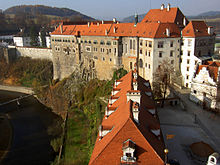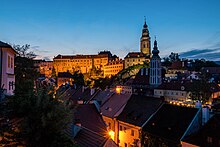Český Krumlov Castle
The Castle Český Krumlov (German Castle Krumlov ) is located in the town of the same name Český Krumlov (Krumau) . It developed from a castle that was built around 1240 by the Český Krumlov family branch of the Witigonen .
The entire area was declared a national cultural monument in 1989 and added to the UNESCO World Heritage List in 1992.
meaning
The castle is located above a ford on an elongated, high rock ledge, which is surrounded by the Vltava in the south and the Polečnice in the north . Because of its architecture and historical importance, it is one of the most important architectural monuments in Central Europe. It is the second largest historical building in the Czech Republic after the Prague Castle . Forty buildings and palaces as well as five courtyards and the palace garden are located on the seven-hectare palace area. Valuable Renaissance and Baroque rooms and halls with art objects from the last five centuries have been preserved throughout the complex . The collection of Flemish tapestries and the large picture exhibition are valuable . The rococo chapel and the large mask room with illusionistic paintings by Josef Lederer from 1748 are worth seeing. One of the curiosities is a golden carriage from 1638, which Johann Anton I von Eggenberg took with him to an audience with Pope Urban VIII . The large baroque theater is located in the fifth courtyard . Today there are performances as part of the annual baroque festival in June. In the palace garden there is a pleasure palace, a cascade fountain and a revolving grandstand for summer musical theater performances . Bears have been kept in the moat since the end of the 16th century.
history
The name of Krumau Castle can be derived from the Middle High German Crumbenouwe . He describes the landscape on which the castle is located as a crooked ouwe , i.e. a spot on a crooked meadow . The oldest written mention of the castle comes from the period 1240–1242, when it was immortalized by the Austrian knight and minstrel Ulrich von Liechtenstein in his poem " Frauendienst ".
The first documentary mention of "Chrumbenowe" can be found in a document from the Austrian Duke Ottokar from 1253. At that time, the castle belonged to "Witiko de Chrumbenowe" , who was a grandson of the progenitor Witiko d. Ä. of the witigon family branch of the Lords of Krumau . In the second half of the 13th century, the lower castle with a round tower was built on the site of today's castle . After the death of Wok von Krumau in 1302, with which the Krumlov family branch became extinct, his possessions were transferred to the likewise witigon family branch of the Rosenbergs .
Heinrich I von Rosenberg moved his seat from Rosenberg Castle to Krumau Castle, which served the Rosenbergs as a residence for three centuries. Heinrich's son Peter I von Rosenberg built the Upper Castle in the first third of the 14th century . Ulrich II von Rosenberg had the living quarters of the Upper Castle converted into a three-wing palace from 1444 to 1447. There is also the small chapel from the years 1430–1440, which houses a folding altar with the monogram of the master "IP" from the 1st quarter of the 16th century. 1503–1513 there was a further renovation in the late Gothic style according to plans by the builder Ulrich Pesnitzer from Burghausen . After 1550, the then regent Wilhelm von Rosenberg , who held the office of the Bohemian Land Chamberlain and High Burgrave, initiated a comprehensive redesign of the castle, in which, in addition to the private apartments, several state rooms, including the Golden Hall, were created. The Italian builders Antonio Ericer and Baldassare Maggi were in charge of the renovations . In 1580 Wilhelm von Rosenberg had the tower added and connected with a Renaissance arcade. Around 1590 he built the small castle.
After Wilhelm's death, his younger brother Peter Wok von Rosenberg took over the reign . Due to increasing indebtedness due to the exhaustion of the silver mines, he had to sell the castle and the Krumlov estate to Emperor Rudolf II . He left the castle to his illegitimate son Julius d'Austria , whom he imprisoned in the castle until his death in 1609. After the Battle of the White Mountain , Ferdinand II donated the castle and lordship of Krumau to the Styrian noble Eggenberg family in 1622 . She had earned merit in the Catholic League and was rewarded in this way. Under their rule, the Upper Castle was expanded in a baroque style in 1680, with the castle garden also being laid out and a wooden theater building erected in it. 1706–1708 the construction of the Bellaria summer residence took place.
From 1719 to 1947, the castle and manor Krumau belonged to the aristocratic Schwarzenberg family without interruption . During their reign, the Český Krumlov castle residence was redesigned in the Viennese Baroque style in the 18th century. From 1728–1730 the castle mint building was expanded according to a plan by Anton Erhard Martinelli , and in 1747 the winter riding school was built according to plans by Andrea Altomonte. In addition, the upper floors of the private residence and the St. Georg castle chapel were expanded and the Bellaria pleasure palace and the mask room were painted. In 1760 the new palace theater was built . With the expansion of the coat bridge in 1767, a three-storey connecting corridor was created between the residence, garden and theater.
When the Princely Schwarzenberg family moved to Frauenberg in 1871, the castle lost its function as a residence, but remained a stately administrative center.
In 1988 and 1989, the castle served as the backdrop for the fairy tale film Seven in One Stroke , a film adaptation of the fairy tale of the brave little tailor .
literature
- Joachim Bahlcke , Winfried Eberhard, Miloslav Polívka (eds.): Handbook of historical places . Volume: Bohemia and Moravia (= Kröner's pocket edition . Volume 329). Kröner, Stuttgart 1998, ISBN 3-520-32901-8 , pp. 53-57.
- Castles, pens and chateaus in the Waldviertel, Danube region, South Bohemia, Vysočina, South Moravia regions. ISBN 978-3-9502262-2-5 , p. 23 f
Web links
Coordinates: 48 ° 48 ′ 45 ″ N , 14 ° 18 ′ 55 ″ E







